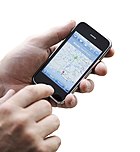History of radio § Broadcasting
Two way voice communication
A two-way radio is an audio transceiver, a receiver and transmitter in the same device, used
for bidirectional person-to-person voice communication. An older term for this
mode of communication is radio telephony. The radio link may
be half-duplex, as in a walkie-talkie, using a single radio channel
in which only one radio can transmit at a time, so different users take turns
talking, pressing a "push to talk"
button on their radio which switches off the receiver and switches on the transmitter.
Or the radio link may be full duplex, a bidirectional link using two
radio channels so both people can talk at the same time, as in a cell phone.
·
Cell phone – a portable wireless telephone that is connected to
the telephone
network by radio signals exchanged with a local antenna at
a cellular base
station (cell tower). The service area covered by the
provider is divided into small geographical areas called "cells",
each served by a separate base station antenna and multichannel transceiver. All the cell phones in a cell
communicate with this antenna on separate frequency channels, assigned from a
common pool of frequencies.


The
purpose of cellular organization is to conserve radio bandwidth by frequency reuse. Low power transmitters are
used so the radio waves used in a cell do not travel far beyond the cell,
allowing the same frequencies to be reused in geographically separated cells.
When a user carrying a cellphone crosses from one cell to another, his phone is
automatically "handed off" seamlessly to the new antenna and assigned
new frequencies. Cellphones have a highly automated full duplex digital transceiver using OFDM modulation
working in the UHF or microwave band using two digital radio channels, each
carrying one direction of the bidirectional conversation, as well as a control
channel that handles dialing calls and "handing off" the phone to
another cell tower. Existing 2G, 3G,
and 4Gnetworks use frequencies in the low
microwave range, between 700 MHz and 3 GHz. The cell phone
transmitter usually has two power levels which it switches between when needed:
0.6 W when near a cell tower, and 3 W when farther away, while cell
tower channel transmitter power is 50 W. Current generation phones, called smartphones, have many functions besides
making telephone calls, and therefore have several other radio transmitters and
receivers that connect them with other networks: usually a WiFi modem, a Bluetooth modem, and a GPS receiver.
o G cellular network –
next generation cellular networks which began deployment in 2019. Their major
advantage is much higher data rates than previous cellular networks, up to
10 Gbps; 100 times faster than the previous
cellular technology, 4G LTE. The higher data rates are achieved by using higher
frequency radio waves in or near the millimeter
wave band, around 28 and 39 GHz. Since millimeter waves
are absorbed by atmospheric gases they have shorter range than microwaves.
Therefore 5G cells will be the size of a city block, smaller than the cells in
previous cellular networks which could be many miles across. Instead of a
large cell base
station and antenna tower, 5G networks will have many small
antennas attached to utility poles and buildings.

·
Satellite
phone (satphone) – a portable wireless telephone similar
to a cell phone, connected to the telephone network through
a radio link to an orbiting communications satellite instead of
through cell towers. They are more expensive than cell
phones; but their advantage is that, unlike a cell phone which is limited to
areas covered by cell towers, satphones can be used over most or all of the geographical
area of the Earth. In order for the phone to communicate with a satellite using
a small omnidirectional antenna, first generation
systems use satellites in low earth
orbit, about 400–700 miles (640–1,100 km) above the surface.
With an orbital period of about 100 minutes a satellite can only be in view of
a phone for about 7 minutes, so the call is "handed off" to another
satellite when one passes beyond the local horizon. Therefore large numbers of
satellites, about 66, are required to ensure that at least one satellite is in
view continuously from each point on Earth. Other satphone systems use
satellites in geostationary orbit in which only a few
satellites are needed, but these cannot be used at high latitudes because of
terrestrial interference.
·
Cordless
phone- a landline telephone in which the handset is
portable and communicates with the rest of the phone by a short range full duplex radio link, instead of
being attached by a cord. Both the handset and the base station have low power
FM radio transceivers operating in the UHF band that handle the short range
bidirectional radio link.

·
Land mobile radio system – short
range mobile or portable half-duplex radio
transceivers operating in the VHF or UHF band that can be used without a
license. They are often installed in vehicles, with the mobile units
communicating with a dispatcher at a fixed base station.
Special systems with reserved frequencies are used by first
responder services; police, fire, ambulance, and emergency
services and other government services. Other systems are made for use by
commercial firms such as taxi and delivery services. VHF systems use channels
in the range 30–50 MHz and 150–172 MHz. UHF systems use the
450–470 MHz band and in some areas the 470–512 MHz range. In general,
VHF systems have longer range than UHF but require longer antennas. AM or FM
modulation is mainly used, but digital systems such as DMR are being introduced. Radiated
power is typically limited to 4 watts.[7] These systems
have a fairly limited range, usually 3 to 20 miles (4.8 to 32 km)
depending on terrain. Repeaters installed on tall buildings, hills or mountain
peaks are often used to increase the range, when it is desired to cover a
larger area than line-of-sight. Examples of land mobile systems are CB, FRS, GMRS, and MURS. Modern digital systems, called trunked radio systems, have a digital
channel management system using a control channel which automatically assigns
frequency channels to user groups.
·
Walkie-talkie –
a battery powered portable handheld half-duplex two-way radio, used in land
mobile radio systems.
·
Airband –
radio system used by aircraft pilots to talk to other aircraft and
ground-based air traffic controllers. This vital system
is the main communication channel for air traffic control. For most communication in
overland flights in air corridors a VHF-AM system using
channels between 108–137 MHz in the VHFband are used. This system has a typical
transmission range of 200 miles (320 km) for aircraft flying at cruising
altitude. For flights in more remote areas, such as transoceanic airline
flights, aircraft use the HF band
or channels on the Inmarsat or Iridium satphone
satellites. Military aircraft also use a dedicated UHF-AM band from
225.0–399.95 MHz.
·
Marine radio –
medium range transceivers on ships, used for ship-to-ship, ship-to-air and
ship-to-shore communication with harbormasters They
use FM channels between 156 and 174 MHz in the VHF band with up to 25 watts power, giving
them a range of about 60 miles (97 km). Some channels are half-duplex and
some are full-duplex, to be compatible with the
telephone network, to allow users to make telephone calls through a marine
operator.
·
Amateur radio –
long range half-duplex two way radio used by hobbyists for noncommercial
purposes: recreational radio contacts with other amateurs, volunteer emergency
communication during disasters, contests, and experimentation. Radio
amateurs must hold an amateur radio license and are given a
unique callsign that
must be used as an identifier in transmissions. Amateur radio is restricted to
small frequency bands, the amateur radio bands, spaced throughout the
radio spectrum from 136 kHz to 2.4 GHz. Within these bands amateurs
are allowed freedom to transmit on any frequency with a wide variety of
modulation methods. In addition to radiotelephony,
amateurs are the only radio operators still using obsolete Morse code radiotelegraphy.



Comments
Post a Comment